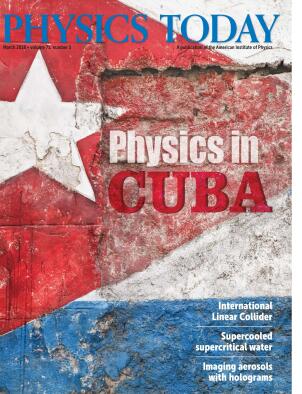Earthquakes can be detected with fiber-optic cable
DOI: 10.1063/PT.3.3866
Over the past decade, researchers in the oil and gas industry developed a technique, distributed acoustic sensing (DAS), to solve a range of on- and offshore reservoir imaging problems. In essence, DAS transforms a straight fiber-optic cable into a one-dimensional array of strain-rate sensors. Here’s how: An electro-optic device illuminates one end of the fiber with short light pulses and performs interferometry on any photons that are backscattered from microscopic heterogeneities in the fiber’s glass core. The interferometric signal changes if the fiber undergoes local strain. By recording the photons’ return times, the device determines the position of any linear stretch or compression on the cable. And by repeatedly firing pulses into the fiber, it can resolve the speed of sound waves.

A team of researchers led by Nate Lindsey (University of California, Berkeley, and Lawrence Berkeley National Laboratory) and Eileen Martin (Stanford University) has now demonstrated that DAS can detect earthquakes nearly as accurately as conventional seismometers. In a field test in Alaska, they buried a 4000 m fiber-optic cable in shallow, orthogonally oriented trenches 20 cm belowground and compared its measurements with those recorded by seismometers placed in the same trenches. When a magnitude 3.8 earthquake occurred after the installation, they converted the fiber strain rates into ground accelerations and found a strong correlation in amplitude and phase with the seismometer records. (The figure shows coauthor Jonathan Ajo-Franklin preparing to install a fiber-optic array for a similar experiment.)
Optical fibers are appealing seismometer proxies because they sense changes along their entire length—potentially tens of kilometers—and are inexpensive, flexible, and insensitive to electrical noise. An additional advantage is that a vast network of currently unused fiber-optic cables already exists in the oceans and throughout the US and other countries—one that may be put back into service for detecting and quantifying earthquakes, the presence of groundwater, changes in permafrost, and other subsurface activities. By comparison, seismometers are sparse and clustered on continents. The researchers have already conducted a proof-of-principle test for leveraging that advantage. Following the trench installations, they ran experiments using a fiber installed inside a preexisting telecommunications infrastructure under Stanford’s campus. The fiber detected events as varied as nearby quarry blasts, small earthquakes in the Bay Area, and larger seismic events across the US. (N. J. Lindsey et al., Geophys. Res. Lett. 44, 11792, 2017, doi:10.1002/2017GL075722
